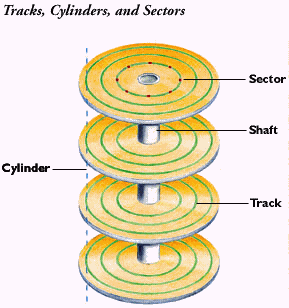[ The PC Guide | Systems and Components Reference Guide | Hard Disk Drives | Hard Disk Geometry and Low-Level Data Structures | Hard Disk Data Tracks, Cylinders and Sectors ]
The Difference Between Tracks and Cylinders
A hard disk is usually made up of multiple platters, each of which use two heads to record and read data, one for the top of the platter and one for the bottom (this isn't always the case, but usually is; see here for more details). The heads that access the platters are locked together on an assembly of head arms. This means that all the heads move in and out together, so each head is always physically located at the same track number. It is not possible to have one head at track 0 and another at track 1,000.
Because of this arrangement, often the track location of the heads is not referred to as a track number but rather as a cylinder number. A cylinder is basically the set of all tracks that all the heads are currently located at. So if a disk had four platters, it would (normally) have eight heads, and cylinder number 720 (for example) would be made up of the set of eight tracks, one per platter surface, at track number 720. The name comes from the fact that if you mentally visualize these tracks, they form a skeletal cylinder because they are equal-sized circles stacked one on top of the other in space.
|
This diagram illustrates what "cylinder"
means on on a hard disk. This |
Image � Quantum
Corporation |
For most practical purposes, there really isn't much difference between tracks and cylinders--its basically a different way of thinking about the same thing. The addressing of individual sectors of the disk is traditionally done by referring to cylinders, heads and sectors (CHS). Since a cylinder is the collection of track numbers located at all of the heads of the disk, the specification "track number plus head number" is equal to "(cylinder number plus head number) plus head number", which is thus the same as "track number plus head number".
![]() Next: Track Density and Areal Density
Next: Track Density and Areal Density
| The PC Guide
(http://www.PCGuide.com) Site Version: 2.2.0 - Version Date: April 17, 2001 © Copyright 1997-2004 Charles M. Kozierok. All Rights Reserved. |
Not responsible for any loss resulting from the use of this site. Please read the Site Guide before using this material. |
